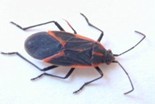Need assistance? Call 800.996.4402

Boxelder bugs get their common name from the fact that they are often found on and around boxelder trees. This species is native to the western states, but can be found from eastern Canada throughout the eastern United States, and west to eastern Nevada wherever boxelder trees are found.
The boxelder bug population lives and thrives on maple and seed-bearing boxelder trees during the warmer months where they lay their eggs and feed on leaves, flowers and seeds. Occasionally, they will feed on the fruits of plum and apple trees.
Boxelder bugs are not known to bite, but their piercing-sucking mouthparts can occasionally puncture skin, causing a slight irritation and producing a red spot similar to a mosquito bite. When crushed or handled roughly, boxelder bugs may leave a reddish orange stain from their fecal material that can result in discoloration of curtains, drapes, clothing, etc.
In autumn, boxelder bugs become gregarious and congregate on the south side of rocks, trees and buildings where the sun hits. After large masses gather, they migrate to nearby buildings or homes to overwinter. These pests tend to hide in small cracks and crevices in walls to insulate themselves from the cold winter temperatures. In late March to early April, adults leave their overwintering sites to return to their host trees for the warmer months.
In order to prevent boxelder bugs from invading homes, repair holes in window and door screens, seal cracks and crevices with a good quality silicone or silicone-latex caulk and install door sweeps to all exterior entrances.
When attempting to get rid of boxelder bugs that have already entered a home or building, no attempt should be made to kill them in wall voids because dead insect bodies can attract dermestid beetles. Rather, using a vacuum cleaner to remove them may provide temporary relief. The bag should be removed to prevent the bugs from escaping.
If a boxelder infestation is suspected, a licensed pest control operator should be called to evaluate and assess the problem.
For the very best food safety consulting, auditing and training, please visit our strategic partner, CFS Food Safety